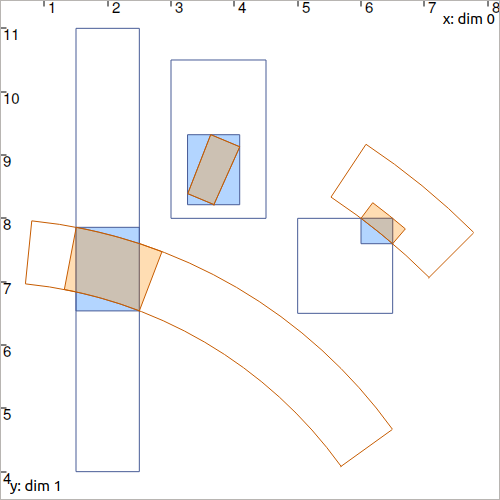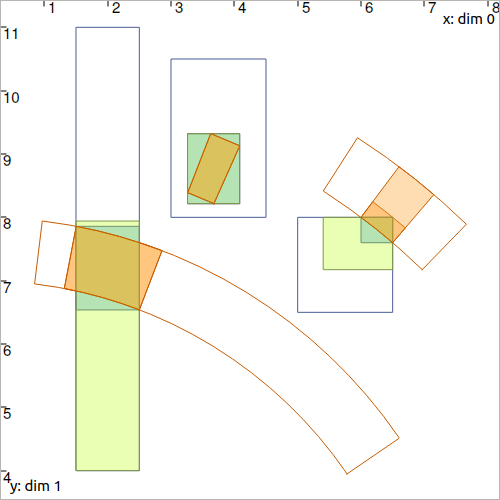See also
This manual refers to Codac v1, but a new v2 implementation is currently in progress… an update of this manual will be available soon. See more.
CtcPolar: \(\big(x=\rho\cos\theta~;y=\rho\sin\theta\big)\)
The \(\mathcal{C}_{\textrm{polar}}\) contractor is mainly used in robotics to express a range-and-bearing constraint. It can be seen as an extension of the previously presented \(\mathcal{C}_{\textrm{dist}}\) enriched with the bearing information. However, its implementation does not stand on the \(\mathcal{C}_{\mathbf{f}}\) contractor presented in the beginning of this chapter. The implementation of \(\mathcal{C}_{\textrm{polar}}\) is minimal and originally comes from the pyIbex library.
Definition
Important
ctc.polar.contract(x, y, rho, theta)
ctc::polar.contract(x, y, rho, theta);
Optimality
This contractor is optimal.
Example
Suppose that we want to estimate the distance \(d^i\) and angle \(\theta^i\) (bearing) between a vector \(\mathbf{x}=(0,0)^\intercal\) and a vector \(\mathbf{b}^i\), \(i\in\{1,2,3\}\).
We define domains (intervals and boxes):
\([\mathbf{x}]=[0,0]^2\)
\([\mathbf{b}^1]=[1.5,2.5]\times[4,11]\), \([d^1]=[7,8]\), \([\theta^1]=[0.6,1.45]\)
\([\mathbf{b}^2]=[3,4.5]\times[8,10.5]\), \([d^2]=[9,10]\), \([\theta^2]=[1.15,1.2]\)
\([\mathbf{b}^3]=[5,6.5]\times[6.5,8]\), \([d^3]=[10,11]\), \([\theta^3]=[0.8,1]\)
x = IntervalVector(2,Interval(0))
d = [Interval(7,8), Interval(9,10), Interval(10,11)]
theta = [Interval(0.6,1.45), Interval(1.15,1.2), Interval(0.8,1)]
b = [IntervalVector([[1.5,2.5],[4,11]]), \
IntervalVector([[3,4.5],[8,10.5]]), \
IntervalVector([[5,6.5],[6.5,8]])]
IntervalVector x(2,0.);
Interval d1(7.,8.), theta1(0.6,1.45);
IntervalVector b1{{1.5,2.5},{4,11}};
Interval d2(9.,10.), theta2(1.15,1.2);
IntervalVector b2{{3,4.5},{8,10.5}};
Interval d3(10.,11.), theta3(0.8,1.);
IntervalVector b3{{5,6.5},{6.5,8}};
Calls to \(\mathcal{C}_{\textrm{polar}}\) will allow the contraction of the \([\mathbf{b}^i]\), \([d^i]\) and \([\theta^i]\):
ctc_polar = CtcPolar()
for i in range(0,3):
ctc_polar.contract(b[i][0], b[i][1], d[i], theta[i])
ctc_polar.contract(b[i][0], b[i][1], d[i], theta[i])
ctc_polar.contract(b[i][0], b[i][1], d[i], theta[i])
# note that we could also use directly the ctc.polar object already available
CtcPolar ctc_polar;
ctc_polar.contract(b1[0], b1[1], d1, theta1);
ctc_polar.contract(b2[0], b2[1], d2, theta2);
ctc_polar.contract(b3[0], b3[1], d3, theta3);
// note that we could also use directly the ctc::polar object already available

Fig. 17 Illustration of several contracted boxes and pies with the above ctc_polar contractor. The blue boxes \([\mathbf{b}^i]\) have been contracted as well as the pies \([d^i]\times[\theta^i]\).
